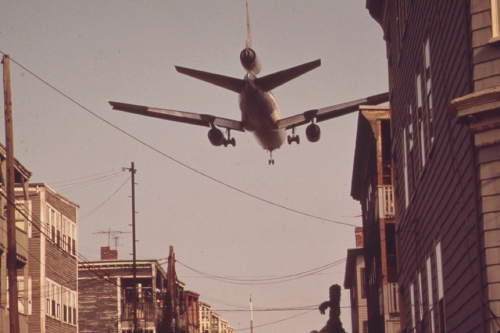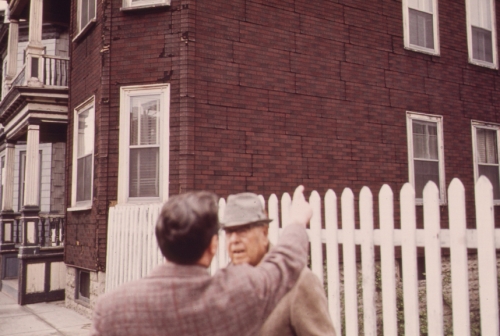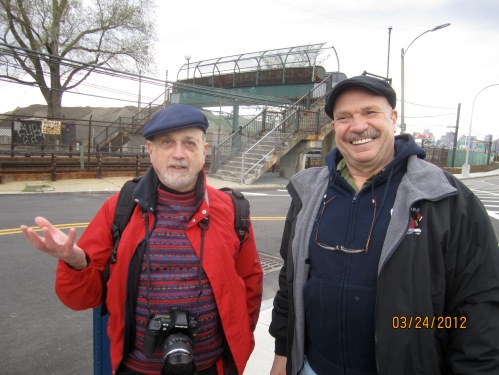Logan Airport Noise?
Call the Massport Noise Complaint Line at 617-561-3333!
I was watching the Bruins play Toronto on May 8, 2013 and as much as I wanted to watch the game, I was falling asleep in my chair, so I taped it and went to bed. It was shortly after 10 pm and I fell very soundly asleep in a matter of minutes.
At 10:19 pm I was woken up by a very noisy jet. I thought that this was odd because I had not heard one all night and usually when there is a Northwest wind, I can hear them taking off on runway 33L every couple of minutes. I think I heard one more jet that night and I fell back asleep pretty quickly.
Photo by Michael Philip Manheim – Jet coming in for a landing over Neptune Road, East Boston MA homes 05/1973. http://www.flickr.com/photos/usnationalarchives/sets/72157620726678645/
Now, I have called the Massport Noise Complaint Line at 617-561-3333 in the past and I should have called the next day but like so many other people, I didn’t. This line is staffed from 7:00 a.m. to 4:30 p.m. on business days.
Eventually, I did look up the jet on the Airport Monitor and to my surprise it was an Arrival. I saw it coming in over Quincy and flying right over my house at 5,900 feet. It was a Boeing 738 and it headed north up to Andover, turned clockwise and landed on runway 22. If you want to find out what type of jet you are hearing, you can check http://www.massport.com/environment/environmental_reporting/Noise%20Abatement/AirportMonitor.aspx
Anthony Bruno (Left) with 92 Year-Old James Morse, Resident of the Neptune Rd, East Boston Neighborhood Closest to Logan
Photo by Michael Philip Manheim – http://www.flickr.com/photos/usnationalarchives/sets/72157620726678645/
I did call Dorothy Connolly Steele, the Massport Manager of Government and Community Affairs, and told her that people have been complaining about the noise at the Medford City Council meetings and she asked me to share the following information with Medford residents and the City Council:
“As you know Medford is affected by Logan airport’s runway 33L over flights. During the 2012 calendar year, of the 2,322 calls received by Massport’s noise abatement department 15 were from 10 Medford callers. Since January 2013 Massport has received 2 noise complaint calls from Medford residents.”
Michael P Mannheim and Jim Morse (Grandson of James Morse) near Neptune Rd and Lovell St in 2012.
How Logan Airport Works
Massport’s website http://www.massport.com has a plethora if information about Massport’s policies, programs and operations and several pages are dedicated to educating the public about Massport’s noise abatement programs and how Logan Airport works. I’ve included some basic information below which is copied from the pages at this link http://www.massport.com/environment/environmental_reporting/noise%20abatement/overview.aspx. We would appreciate your sharing this link and information with interested Medford residents and council members.
Logan’s airfield layout consists of six runways, which vary in length from 2,557 feet to 10,081 feet. Logan’s runways are aligned in three directions with runway ends pointing toward six distinct compass headings. Aircraft must generally take off and land into the wind, so the availability of specific runway configurations is determined by wind speed and direction, and other weather conditions. The runway layout provides necessary operating flexibility given Logan’s coastal location and highly variable wind conditions. Non-coastal airports that do not experience the same variation in wind conditions may have a simpler airfield layout and fewer required operating configurations.
Runway use configurations
There are several primary runway configurations in use at Logan, with over 80 operating subsets of these configurations. The operational capacities of Logan’s existing configurations range from a maximum of approximately 120 operations per hour when the weather is good, winds are light, and three runways are available, to fewer than 60 hourly operations for a single runway.
Logan’s highest capacity configurations have three active runways which allow FAA controllers to segregate arriving aircraft of different size classes into two arrival streams and to use the third runway for aircraft departures. High capacity runway configurations are available at Logan nearly 80 percent of the year. For the remaining part of the year, poor wind and weather conditions restrict the airport to low capacity configurations with just one or two available runways.
The northeast-southwest-northwest configurations are the highest capacity configurations at Logan. These include the runways 4l, 4r, and 9 configuration, runways 22l, 22r, and 27 configuration and the runways 33l, 32 and 27 configuration. With three available runways, these configurations maximize the airports operating efficiency by providing two runways for arriving aircraft, which permits air traffic control to segregate aircraft of different size classes. Conversely, when the airport is restricted to a two-runway or one-runway configuration due to very strong winds, low visibility or snow conditions for example, with a single arrival stream, airfield capacity drops significantly.
Winds from different directions occur at Logan during a typical year. In light winds and good visibility, high capacity three-runway configurations are generally available. With moderate northeast and southwest winds, Logan can also operate on high capacity runway configurations. With northeast winds, the runways 4l, 4r and 9 configuration is available for use. When wind direction shifts to the southwest, the runways 22l, 22r and 27 configuration is used. When winds shift to the northwest, the runways 33l, 32 and 27 configuration is used when winds are from the southeast, runways 15r, 9, 14, and 15l are used.



